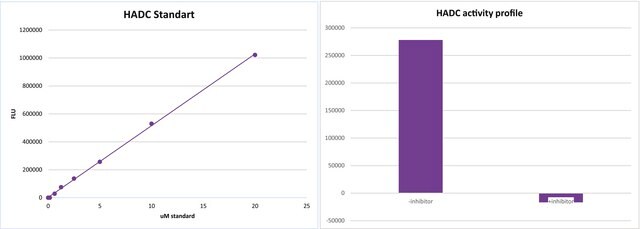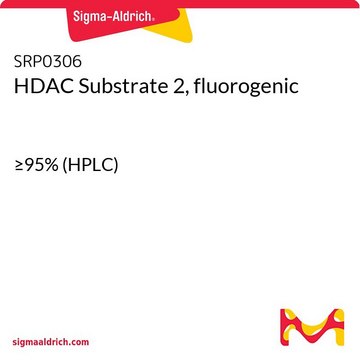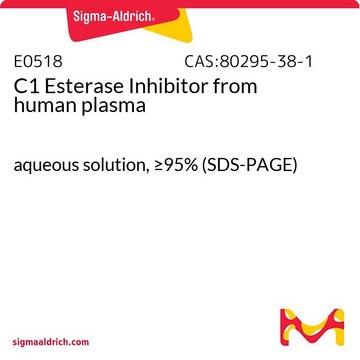EPI003
In Situ Histone Deacetylase (HDAC) Activity Fluorometric Assay Kit
100 assays in 96 well plates
About This Item
Recommended Products
usage
100 assays in 96 well plates
shipped in
wet ice
storage temp.
−20°C
General description
Sigma′s InSitu HDAC Activity Fluorometric Assay Kit provides a direct, fast, fluorescence-based method to measure HDAC activity in cultured cells. The procedure requires just two steps, both performed in the original 96-well cell culture plate. First, the cell culture medium is replaced with a cell permeable HDAC Substrate, containing an acetylated lysine side chain. During the subsequent incubation, HDAC Substrate enters the cells and is deacetylated by intracellular HDAC. In the second step, Developer is added to lyse the cells and cleave the deacetylated HDAC Substrate to release a fluorophore. The fluorescence generated can be quantified at Ex/Em = 368/442 nm. The assay is well suited for either individual or high throughput screening.
Application
Biochem/physiol Actions
Features and Benefits
- Simple two-step sensitive and reliable assay
- All steps performed in the same cell culture plate
- Utilizes fluorometric method
- Sample type: cultured, adherent, and suspension cells
- Suitable for individual tests or high throughput assays and kinetic studies
- Convenient 96-well microplate format
- Suitable for screening HDAC inhibitors or activators
- Suitable for studying growth factors or other regulators that influence HDAC activity
related product
Signal Word
Warning
Hazard Statements
Precautionary Statements
Hazard Classifications
Aquatic Chronic 3 - Eye Irrit. 2
Storage Class Code
10 - Combustible liquids
Flash Point(F)
188.6 °F - closed cup
Flash Point(C)
87 °C - closed cup
Regulatory Listings
Regulatory Listings are mainly provided for chemical products. Only limited information can be provided here for non-chemical products. No entry means none of the components are listed. It is the user’s obligation to ensure the safe and legal use of the product.
PDSCL
Please refer to KIT Component information
PRTR
Please refer to KIT Component information
FSL
Please refer to KIT Component information
ISHL Indicated Name
Please refer to KIT Component information
ISHL Notified Names
Please refer to KIT Component information
Cartagena Act
Please refer to KIT Component information
JAN Code
キットコンポーネントの情報を参照してください
Certificates of Analysis (COA)
Search for Certificates of Analysis (COA) by entering the products Lot/Batch Number. Lot and Batch Numbers can be found on a product’s label following the words ‘Lot’ or ‘Batch’.
Already Own This Product?
Find documentation for the products that you have recently purchased in the Document Library.
Our team of scientists has experience in all areas of research including Life Science, Material Science, Chemical Synthesis, Chromatography, Analytical and many others.
Contact Technical Service








